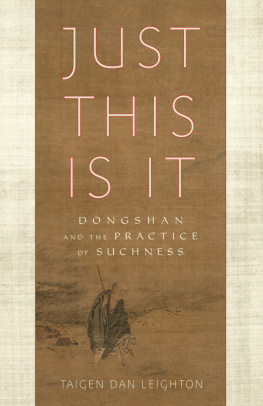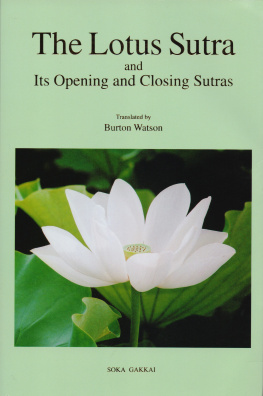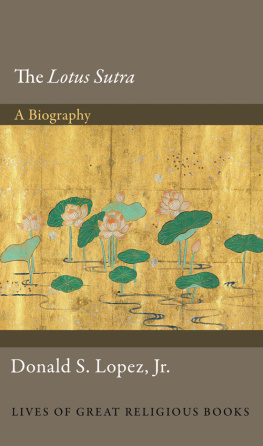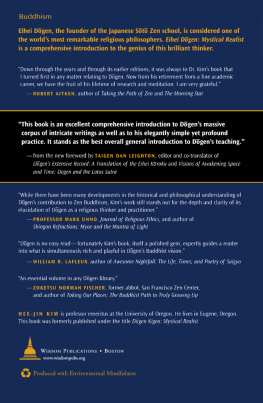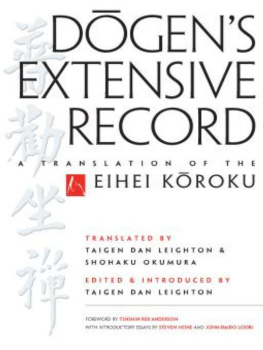Preface
In the striking story from the Lotus Sutra that is one starting point for this work, an incalculable number of venerable, dedicated bodhisattvas, or enlightening beings, emerge suddenly from an open space under the earth to pledge to the Buddha Sakyamuni their assistance in keeping alive his teaching, even far into the future. This tale of chthonic bodhisattvas emerging from under the ground resonates with a number of mythic and historical narratives. Comparing such images may provide some illuminating metaphoric contexts for this story, which begins chapter 15 of the sutra.1Although a survey of analogous mythological references is beyond the scope of this work, a particularly instructive comparison to the story of emerging bodhisattvas is a modern account by spiritual writer Annie Dillard of an experience she had in 1982. Her story reaches back in time to around 206 BCE, historically within a century before the Lotus Sutra began to be committed to writing, and to events in China some six centuries before Kumarajlva translated the standard version of the Lotus Sutra used there.2Dillard visited the tomb of the Qin emperor near Xi'an (formerly Chang'an) as the thousands of clay soldiers buried with the emperor who had first unified China were being unearthed after their recent discovery in 1974. As her eyewitness response is a key part of the comparison, I quote Dillard at some length:Chinese archaeologists were in the years-long process of excavating a buried army of life-sized soldiers. The first Chinese emperor, Emperor Qin, had sculptors make thousands of individual statues. Instead of burying his army of living men to accompany him in the afterlife a custom of the timehe interred their full-bodied portraits.At my feet, and stretching off into the middle distance... I saw what looked like human bodies coming out of the earth.... From the trench walls emerged an elbow here, a leg and foot there, a head and neck. Everything was the same color, the terra-cotta earth and the people: the color of plant pots.Everywhere the bodies, the clay people, came crawling from the deep ground. A man's head and shoulders stuck out of a trench wall. He wore a helmet and armor. From the breast down, he was in the wall. The earth bound his abdomen.... I looked down into his face. His astonishment was formal.The earth was yielding these bodies, these clay people: it erupted them forth, it pressed them out. The same tan soil that embedded these people also made them; it grew and bore them. The clay people were earth itself, only shaped.3The first obvious difference is that this uncovering of entombed soldiers is a historical event, unlike the literary, scriptural emergence from the earth of spiritual benefactors in the Lotus Sutra. However, as Donald Lopez traces the term "bodhisattva," the Sanskrit word bodhi is the state of being awake, and the Sanskrit term sattva has etymological roots that include ''sentient being,'' ''mind'' or ''intention,'' but also ''the sense of strength or courage, making the compound bodhisattva mean 'one whose strength is directed toward enlightenment.' '' This meaning was later emphasized in the Tibetan translation for bodhisattva, which means literally ''enlightenment-mind-hero,'' or ''one who is heroic in his or her intention to achieve enlightenment.''4 This meaning may have been reinforced by the historical Sakyamuni Buddha having previously been a prince well-trained in martial arts. Thus the bodhisattva has sometimes been associated with warrior strength and courage and with the heroic aspect of dedication to awakening.As a further parallel, East Asian Mahayana imagery frequently discusses the relationship of teachers and students, or buddhas and bodhisattvas, using metaphors of lords and vassals, based on the relationship of Chinese emperors to their soldiers and government ministers. So it seems that the Chinese soldiers buried under the earth for all those centuries are not an inappropriate analogue for the underground bodhisattva retainers of Buddha.Of course, one prime facet of the Lotus Sutra underground bodhisattvas is their long-lived practice and enduring availability, whereas the Xi'an soldiers are mere ''clay people.'' However, Dillard's reaction to observing how ''the earth was yielding these bodies, these clay people: it erupted them forth, it pressed them out,'' is a revealing comparison for the emerging from earth of the bodhisattvas. First, we simply note the earthiness of the Qin soldiers, clay people colored terra-cotta, of ''the earth itself, only shaped.'' The Lotus Sutra bodhisattvas are alive, not molded from terra-cotta. And yet they have been under the earth, in the open space under the ground, for longer, much longer, than the two-millennia-old Qin dynasty soldiers, and these bodhisattvas also profoundly represent the earth element.Another noteworthy aspect of Dillard's account is her astonishment at the partial exposure of the soldiers, like Michelangelo's striking figures still half-embedded in stone. It is as if Dillard were seeing the bodhisattvas' rapid emergence in extreme slow motion. And her astonishment at the sight is reminiscent of the puzzled confusion of the Buddha's regular disciples in the sutra story.Yet Dillard transposes this shock and bewilderment to the soldiers themselves: ''A man's head and shoulders stuck out of a trench wall. The earth bound his abdomen.... I looked down into his face. His astonishment was formal.'' Dillard's account allows us to wonder at the contrasting response of the Lotus Sutra underground bodhisattvas, as they suddenly emerged after vast ages beneath the earth. Their eruption is itself so startling that we might neglect the perhaps equally amazing readiness that they exhibit in promptly making offerings to the Buddha and proclaiming their availability to sustain the Dharma, with no befuddlement or hesitation themselves after their astonishing, sudden emergence. From their extraordinary performance of enduring service and dedication, one might derive much concerning the spiritually nourishing nature of earth and of time in the Mahayana, and we will see that certainly Dogen does so.The underground bodhisattvas express the immanence of the liberative potential, or buddha nature, in the ground of the earth, as well as in the inner, psychological ground of being, ever ready to spring forth and benefit beings when called. The image represents the fertility of the earth itself and the wondrous, healing, natural power of creation, or the phenomenal world.This work explores this section of the Lotus Sutra and how it was used by the thirteenth-century Japanese Zen master Eihei Dogen to express his dynamic worldview. The first chapter presents the story of Lotus Sutra chapters 15 and 16, beginning with the underground bodhisattvas emerging to maintain the sutra's teaching long into the future, leading to the revelation of the Buddha's inconceivably long life span. This story is pivotal to the sutra's meaning and to its literary structure, as early Chinese commentators Daosheng and Zhiyi viewed the story as dividing the earlier cause or practice section from the effect, or fundamental teaching, later section of the sutra. The worldview of Dogen in which space itself becomes awakened and is mutually, interactively supportive with practitioners is also introduced.The second chapter presents a range of hermeneutical and methodological considerations related to Dogen and the Lotus Sutra, discussing approaches particularly relevant to Dogen: skillful means; Tathagata garbha, or buddha womb teaching; and practice as enactment of realization. This is followed by pertinent considerations from Paul Ricoeur's Western hermeneutical perspectives on use of metaphor and wordplay as a context for appreciating Do-gen's creative use of language, and Ricoeur's writings about proclamation that are illuminating of Dogen's discourse style, which to a great extent explicitly draws from the Lotus Sutra. Also discussed is the new interest in the strong role of imagery and imagination in Buddhism, important for both Mahayana sutras and for Dogen.Chapter 3 traces the responses and commentaries to the Lotus Sutra, especially to its chapters 15 and 16, from a series of prominent East Asian Buddhist teachers. Featured in these discussions are early Chinese teachers Daosheng, Zhiyi, and Zhanran; Dogen's rough contemporaries in Japan, Saigyo, Myoe, and Nichiren; and the commentaries of later Japanese Zen figures Hakuin, Ryokan, and the modern master Shunryu Suzuki. Among major issues that these contrasting responses address are the nature of the earth and the practice relationship to this world; the manner in which this Lotus Sutra story applies to later, ongoing practice; and the nature of the Buddha himself in the light of this story.Chapter 4, in many ways the heart of this book, is a close reading of a range of references throughout Dogen's writings to Lotus Sutra chapters 15 and 16, organized in terms of earth, space, and time, and then by how Dogen uses these citations as practice encouragements for his students. These commentaries reveal Dogen's strong lifetime allegiance to the Lotus Sutra text, and also his approach to awakening as a function of the nature of reality, intimately connected with the dynamic support of the earth, space itself, and a multidimensional view of the movements of time.Chapter 5 discusses a range of Mahayana imagery concerning earth, space, and their confluence and related Buddhist backgrounds on temporality, and how these may have served as a wider context for Doagen's worldview beyond the Lotus Sutra as his major Mahayana source. David McMahan's discussions of


